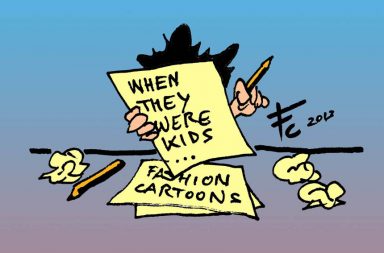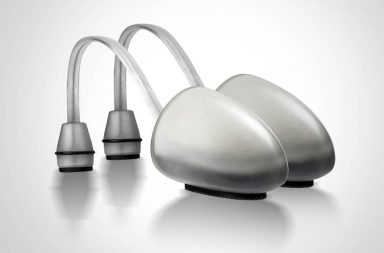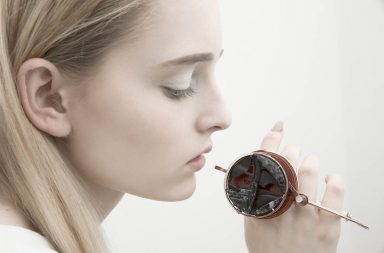Can everyday objects, like a comb, a pen or a notebook transmit hidden messages through their design and the effect that they have on the senses?
This question sums up the thesis behind the lasted collection from Mirja Pitkäärt’s, the promising young Estonian designer and winner of the Accessories Collection of the Year award at this year’s International Talent Support.
Her collection, Objects of Enduring Value, is a collection of exquisite and distinct pieces that come together to express an idea: everyday objects can be beautiful, long lasting, pieces of art that help us to reflect on the importance of ethical consumerism and its place in society.

Mirja Pitkäär
Mirja Pitkäärt, a native of Estonia currently residing in Paris, has a special ability to create accessories that exist in between product design and fashion design. She’s just finished an MA in Fashion Artefact at the London College of Fashion and also studied Leather Design at the Estonian Academy of Arts and Textile Design at the University of Applied Arts in Vienna. Mirja has worked in Berlin, London and Paris for brands such as Anja Bruhn, Fleet Ilya, Ally Capellino and Louis Vuitton, specialising in luxury leather products.
Recently she sat down with the team at So Catchy! Where Fashion Begins to talk about her new collection, Objects of enduring value, and her reaction to winning the prestigious Accessories Collection of the Year award from ITS.

SO CATCHY!: How do you feel after winning the Accessories Collection of the Year from the ITS competition 2014?
MIRJA PITKÄÄRT: ITS was an amazing experience and being recognised with the award was a great honour for me. Of course I did not dare to expect it so I was quite overwhelmed and it took me a long time to realise that I won. Now I’ve had some time to digest it and I’m really exited to make a new collection and to be in Trieste again next year.
SC!: What did the jury say about your collection?
MP: There wasn’t much space for feedback at the presentation but everyone was curious about the pieces and wanted to touch and hold them in their hands, which is the best reaction in my eyes.
SC!: Why did you decide to focus your career on accessories?
MP: I studied leather design in the Estonian Academy of Arts, which gave me a great basis in traditional leatherwork and an introduction into accessory design. I liked the balance between fashion and product design but with great emphasis on knowing how to make and being quite technical. After graduating and before starting my MA in London I worked for different designers mainly on relatively small-scale production of leather goods. With work experience I got more familiar with the world of fashion accessories and also got a lot of practice in making.

SC!: Can you explain the concept behind your winning collection, Objects of enduring value?
MP: The aim of the project was to materialise an attempt to design products of ordinary function that could enrich our daily life and do so for a sustained period of time. In order to create appropriate conditions for long lasting, meaningful relationships with the objects to emerge, I concentrated on the use of tactile materials and shapes to design sincere objects that have a purpose, age well and allow a satisfying sensation of touch. I gave objects that are familiar to us from everyday use a new shape, material, and sense that would give a more rewarding haptic experience and would therefore prolong their lifespan. The collection of artefacts translates my personal understanding of emotionally durable design projected on a selection of objects.
SC!: How did you produce these objects, what techniques did you use?
MP: I was working between the areas of the hand-made and mass-production, I used CNC milling to create the shapes and the pen was made on a woodturning lathe. I was lucky enough to have access to a CNC milling machine in the college workshop, so I spent the whole summer learning a 3D design software and teaching myself how operate the machine. Being able to produce the whole collection by myself gave me a lot of freedom to try everything out and change the design along the way. The main material was model board that is sort of an artificial wood that I then covered with light grey veg tan leather. The other main material was wood, namely maple wood and african blackwood. I chose materials that are pleasurable to feel and that have a way of ageing that doesn’t decrease their value. The light coloured leather will pick up a lot of marks and scratches with use and will get darker over time in sunlight.
SC!: Why did you want to focus your work on midpoint between the 2 ways of doing fashion: fast-fashion and slow-fashion?
MP: I don’t think my interest lies as much with the fashion industry as in our habits in general. After constantly moving around for years I started to pay much more attention to my belongings and to limit the consumption of unnecessary things. I wanted to work between the areas of fashion, craft and product design and create products that would make us re-evaluate everything around us.

SC!: Do you think the way people understand fashion is changing nowadays, I mean, do you think people appreciate the quality and authenticity of the objects more than of mass-producing ones?
MP: I think that people are definitely more conscious about the consequences of overconsumption but at the same time there is more choice than ever and we are constantly being seduced to buy something.
SC!: Define your objects with 3 words.
MP: Honest, tactile, valuable
SC!: What´s your favourite material to work with and why?
MP: I am most familiar and used to working with leather but working with hardwoods became a new favourite of mine during the making of my final collection. I like to work with materials that have a certain character and uniqueness to them, like the knots and lines in the wood or scars on the leather.

SC!: What are you going to do next?
MP: I have recently moved to Paris where I am working for a fashion house but for the next year I will use all my spare time to work on my new collection for ITS and I’m sure more challenges will come along.
SC!: Do you have any idea what your next collection will be like?
MP: I would like to keep discovering designing and making processes so I think it will be again a variety of products and possibly something new for my expertise.
SC!: What inspires you?
MP: The world around me
SC!: You can’t live without…
MP: Space and time for myself
Photos courtesy of Agnes Lloyd-Platt
Translation and Layout by Michael Padilla




